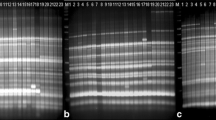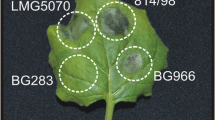Abstract
Bacterial canker of kiwifruit, caused by Pseudomonas syringae pv. actinidiae, is responsible for significant economic losses, both in yield and quality. A collection of P.s. pv. actinidiae isolated in Northern and Central Italy, during the first severe outbreak (2008–2010) and a few years afterwards (2014), when the pathogen became endemic and established, was gathered. The genetic diversity was evaluated with rep-PCR, RAPD-PCR, and MLSA of six housekeeping and effector genes. On the same strains, the virulence was evaluated in vitro and in vivo, showing a higher disease index for the strains isolated in 2014, compared with the strains of 2010. The molecular fingerprinting, obtained by rep and RAPD analysis, revealed a high level of variability in the population of strains of P.s. pv. actinidiae from northern Italy. All the parameters considered – Na, Ne, H, I, polymorphic loci, and AMOVA – showed a higher genetic diversity within the population of northern Italy isolated in 2014, compared to the older population. The study of the genetic diversity and virulence permitted to show an increase of virulence and genetic diversity of the strains. The fast and dramatic epidemics caused by P. s. pv. actinidiae could be an interesting model to study the changes in the genetic diversity and virulence of a bacterial pathogen.





Similar content being viewed by others
References
Andolfi, A., Ferrante, P., Petriccione, M., Cimmino, A., Evidente, A., & Scortichini, M. (2014). Production of phytotoxic metabolites by Pseudomonas syringae pv. actinidiae, the causal agent of bacterial canker of kiwifruit. Journal of Plant Pathology, 96, 169–176.
Balestra, G. M., Mazzaglia, A., Quattrucci, A., Renzi, M., & Rossetti, A. (2009). Occurrence of Pseudomonas syringae pv. actinidiae in Jin Tao kiwi plants in Italy. Phytopathologia Mediterranea, 48, 299–301.
Burdon, J. J. (1993). Genetic variation in pathogen populations and its implications for adaptation to host resistance. In T. Jacobs & J. E. Parlevliet (Eds.), Durability of disease resistance (pp. 41–56). Dordrecht: Kluwer.
Buttner, D., & Sheng Yang, H. (2009). Type III protein secretion in plant pathogenic bacteria. Plant Physiology, 150, 1656–1664.
Chapman, J. R., Taylor, R. K., Weir, B. S., Romberg, M. K., Vanneste, J. L., Luck, J., & Alexander, B. J. R. (2012). Phylogenetic relationships among global populations of Pseudomonas syringae pv. actinidiae. Phytopathology, 102, 1034–1044.
Choi, E. J., Lee, Y. S., Kim, G. H., Koh, Y. J., & Jung, J. S. (2014). Phenotypic characteristics of Pseudomonas syringae pv. actinidiae strains from different geographic origins. Korean Journal of Microbiology, 50, 245–248.
Cunty, A., Poliakoff, F., Rivoal, C., Cesbron, S., Fischer-Le Saux, M., & Lemaire, C. (2015). Characterization of Pseudomonas syringae pv. actinidiae (psa) isolated from France and assignment of psa biovar 4 to a de novo pathovar: Pseudomonas syringae pv. actinidifoliorum pv. Nov. Plant Pathology, 64, 582–596.
EPPO, (2012). Pseudomonas syringae pv. actinidiae. Bacterial canker of kiwifruit. Available [http://www.eppo.int/QUARANTINE/Alert_List/bacteria/P_syringae_pv_actinidiae.htm]. Accessed on December 13, 2016.
FAOSTAT, 2014. [http://faostat3.fao.org/faostat-gateway/go/to/browse/Q/QC/E]. Accessed on May 4, 2017.
Ferrante, P., & Scortichini, M. (2010). Molecular and phenotypic features of Pseudomonas syringae pv. actinidiae isolated during recent epidemics of bacterial canker on yellow kiwifruit (Actinidia chinensis) in central Italy. Plant Pathology, 59, 954–962.
Ferrante, P., & Scortichini, M. (2015). Redefining the global populations of Pseudomonas syringae pv. actinidiae based on pathogenic, molecular and phenotypic characteristics. Plant Pathology, 64, 51–62.
Ferrante, P., Clarke, C. R., Cavanaugh, C. A., Michelmore, R. W., Buonaurio, R., & Vinatzer, B. (2009). Contributions of the effector gene hopQ1-1 to differences in host range between Pseudomonas syringae pv. phaseolicola and P. syringae pv. tabaci. Molecular Plant Pathology, 10, 837–842.
Gallelli, A., L’Aurora, A., & Loreti, S. (2011). Gene sequence analysis for the molecular detection of Pseudomonas syringae pv. actinidiae: Developing diagnostic protocols. Journal of Plant Pathology, 93, 425–435.
Giovanardi, D., Bonneau, S., Gironde, S., Fischer-Le Saux, M., Manceau, C., & Stefani, E. (2015). Morphological and genotypic features of Xanthomonas arboricola pv. juglandis populations from walnut groves in Romagna region, Italy. European Journal of Plant Pathology, 145, 1–16.
Giovanardi, D., Dallai, D., & Stefani, E. (2016). Population features of Xanthomonas arboricola pv. pruni from Prunus spp. orchards in northern Italy. European Journal of Plant Pathology, doi:10.1007/s10658-016-1040-5.
Hartung, J. S., Daniel, J. F., & Pruvost, O. P. (1993). Detection of Xanthomonas campestris pv. citri by the polymerase chain reaction method. Applied and Environmental Microbiology, 59, 1143–1148.
Koh, H. S., Kim, G. H., Lee, Y. S., Koh, Y. J., & Jung, J. S. (2014). Molecular characteristics of Pseudomonas syringae pv. actinidiae strains isolated in Korea and a multiplex PCR assay for haplotype differentiation. The Plant Pathology Journal, 30, 96–101.
Kolliker, R., Kraehenbuehl, R., Boller, B., & Widmer, F. (2006). Genetic diversity and pathogenicity of the grass pathogen Xanthomonas translucens pv. graminis. Systematic and Applied Microbiology, 29, 109–119.
Lee, D. G., Urbach, J. M., Wu, G., Liberati, N. T., Feinbaum, R. L., Miyata, S., & Ausubel, F. M. (2006). Genomic analysis reveals that Pseudomonas aeruginosa virulence is combinatorial. Genome Biology, 7, R90.
Lindeberg, M., Cunnac, S., & Collmer, A. (2012). Pseudomonas syringae type III effector repertoires: Last words in endless arguments. Trends in Microbiology, 20, 199–208.
Louws, F. J., Fulbright, D. W., Stephems, C. T., & De Bruijn, F. J. (1994). Specific genomic fingerprints of phytopathogenic Xanthomonas and Pseudomonas pathovars and strains generated with repetitive sequence and PCR. Applied and Environmental Microbiology, 60, 2286–2295.
Marcelletti, S., & Scortichini, M. (2011). Clonal outbreaks of bacterial canker caused by Pseudomonas syringae pv. actinidiae on Actinidia chinensis and A. deliciosa in Italy. Journal of Plant Pathology, 93, 479–483.
Marcelletti, S., Ferrante, P., Petriccione, M., Firrao, G., & Scortichini, M. (2011). Pseudomonas syringae pv. actinidiae draft genomes comparison reveal strain-specific features involved in adaptation and virulence to Actinidia species. PLoS ONE, 6, e27297.
Mazzaglia, A., Renzi, M., & Balestra, G. M. (2011). Comparison and utilization of different PCR-based approaches for molecular typing of Pseudomonas syringae pv. actinidiae strains from Italy. Canadian Journal of Plant Pathology, 33, 8–18.
McCann, H. C., Bertels, F., Erik, H., Rikkerink, A., Fiers, M., Lu, A., Rees-George, J., Andersen, M. T., Gleave, A. P., Haubold, B., Wohlers, M. W., Guttman, D. S., Wang, P. W., Vanneste, J., Rainey, P. B., & Templeton, M. D. (2013). Genomic analysis of the kiwifruit pathogen Pseudomonas syringae pv. actinidiae provides insight into the origins of an emergent plant disease. PLoS Pathogens, 9, e1003503.
Monchiero, M., Gullino, M. L., Pugliese, M., Spadaro, D., & Garibaldi, A. (2015). Efficacy of different chemical and biological products in the control of Pseudomonas syringae pv. actinidiae on kiwifruit. Australasian Plant Pathology, 44, 13–23.
Picard, Y., Roumagnac, P., Legrand, D., Humeau, L., Robène-Soustrade, I., Chiroleu, F., Gagnevin, L., & Pruvost, O. (2008). Polyphasic characterization of Xanthomonas axonopodis allii associated with outbreaks of bacterial blight on three Allium species in the Mascarene archipelago. Phytopathology, 98, 919–925.
Prencipe, S., Nari, L., Vittone, G., Gullino, M. L., & Spadaro, D. (2016). Effect of bacterial canker caused by Pseudomonas syringae pv. actinidiae on postharvest quality and rots of kiwifruit ‘Hayward’. Postharvest Biology and Technology, 113, 119–124.
Rees-George, J., Vanneste, J. L., Cornish, D. A., Pushparajah, I. P. S., Yu, J., Templeton, M. D., & Everett, K. R. (2010). Detection of Pseudomonas syringae pv. actinidiae using polymerase chain reaction (PCR) primers based on the 16S–23S rDNA intertranscribed spacer region and comparison with PCR primers based on other gene regions. Plant Pathology, 59, 453–464.
Remenant, B., Coupat-Goutaland, B., Guidot, A., Cellier, G., Wicker, E., Allen, C., Fegan, M., Pruvost, O., Elbaz, M., Calteau, A., Salvignol, G., Mornico, D., Mangenot, S., Barbe, V., Médigue, C., & Prior, P. (2010). Genomes of three tomato pathogens within the Ralstonia solanacearum species complex reveal significant evolutionary divergence. BMC Genomics, 11, 379.
Sarkar, S. F., & Guttman, D. S. (2004). Evolution of the core genome of Pseudomonas syringae, a highly clonal, endemic plant pathogen. Applied and Environmental Microbiology, 70, 1999–2010.
Schuenzel, E. L., Scally, M., Stouthamer, R., & Nunney, L. (2005). A multigene phylogenetic study of clonal diversity and divergence in north American strains of the plant pathogen Xylella fastidiosa. Applied and Environmental Microbiology, 71, 3832–3829.
Scortichini, M. (2005). The population structure of some plant pathogenic bacteria: An ecological and adaptive perspective. Journal of Plant Pathology, 87, 5–12.
Scortichini, M., Marchesi, U., Dettori, M. T., & Rossi, M. P. (2003). Genetic diversity, presence of the syrB gene, host preference and virulence of Pseudomonas syringae pv. syringae strains from woody and herbaceous host plants. Plant Pathology, 52, 277–286.
Scortichini, M., Marcelletti, S., Ferrante, P., Petriccione, M., & Firrao, G. (2012). Pseudomonas syringae pv. actinidiae: A re-emerging, multi-faceted, pandemic pathogen. Molecular Plant Pathology, 13, 631–640.
Shapiro, B. J. (2016). How clonal are bacteria over time? Current Opinion in Microbiology, 31, 116–123.
Sisto, A., Cipriani, M. G., Tegli, S., Cerboneschi, M., Stea, G., & Santtili, E. (2007). Genetic characterization by fluorescent AFLP of Pseudomonas savastanoi pv. savastanoi strains isolated from different host species. Plant Pathology, 56, 366–372.
Takikawa, Y., Serizawa, S., Ichikawa, T., Tsuyumu, S., & Goto, M. (1989). Pseudomonas syringae pv. actinidiae pv. Nov.: The causal bacterium of canker of kiwifruit in Japan. Annals of the Phytopathological Society of Japan, 55, 437–444.
Vanneste, J. L. (2013). Recent progress on detecting, understanding and controlling Pseudomonas syringae pv. actinidiae: A short review. New Zealand Journal of Plant Protection, 66, 170–177.
Vanneste, J. L., Cornish, D. A., Yu, J., Audusseau Paillard, S., Rivoal, C., & Poliakoff, F. (2011). Presence of the effector gene hopAl in strains of Pseudomonas syringae pv. actinidiae isolated from France and Italy. New Zealand Plant Protection, 64, 252–258.
Versalovic, J., Schneider, M., De Bruijn, F. J., & Lupski, J. R. (1994). Genomic fingerprinting of bacteria using repetitive sequence based polymerase chain reaction. Methods in Molecular Cell Biology, 5, 25–40.
Acknowledgments
The Authors wish to thank the financial support of Piedmont Region in the framework of the project “PRO.ACT.IN.” (PSR FEASR 2007/2013, European Fund for Rural Development, Measure 124, Action 1). The Authors gratefully acknowledge Dr. Luca Nari and Dr. Graziano Vittone from Agrion, and the growers for their support in sampling, Dr. Giorgio Balestra (Università della Tuscia) for providing the Central Italy and Asian strains, and Dr. Fabiano Sillo (University of Turin) for the support in molecular data analysis.
Author information
Authors and Affiliations
Corresponding author
Ethics declarations
Conflicts of interest
There are no potential conflicts of interest.
Human and animal rights
The research does not involve human participants nor animals.
Informed consent
The research does not involve informed consent.
Rights and permissions
About this article
Cite this article
Prencipe, S., Gullino, M.L. & Spadaro, D. Pseudomonas syringae pv. actinidiae isolated from Actinidia chinensis Var. deliciosa in Northern Italy: genetic diversity and virulence. Eur J Plant Pathol 150, 191–204 (2018). https://doi.org/10.1007/s10658-017-1267-9
Accepted:
Published:
Issue Date:
DOI: https://doi.org/10.1007/s10658-017-1267-9




